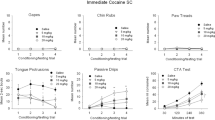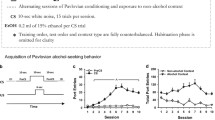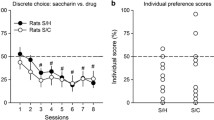Abstract
The present study was designed to determine whether a signal for availability of self-administered ethanol would acquire the ability to elicit a conditioned thermal response and to alter ethanol self-administration. Non-deprived male albino rats (n=8) were exposed to a differential conditioning procedure in which brief (30-min) periods of access to sweetened ethanol on a fixed-ratio operant schedule were either signalled (CS+ trials) or unsignalled (Blank + trials). A different stimulus signalled trials on which barpressing was not reinforced (CS− trials). Body temperature was recorded continuously from implanted telemetry devices. As in previous studies involving experimenter-administered ethanol injections, the stimulus paired with self-administered ethanol (CS+) acquired the ability to elicit a conditioned increase in body temperature. Moreover, barpressing for ethanol was greater on signalled trials (CS+) than on unsignalled trials (Blank +), indicating that ethanol's reinforcing efficacy was altered by CS+. Ethanol self-administration was significantly correlated with the anticipatory increase in body temperature on CS+ trials (Pearsonr=+0.77). When ethanol was removed, leaving sucrose alone as the reinforcer, the signal's effect on barpressing was eliminated. This finding suggests the signal's effect depended on ethanol's pharmacological properties. In general, these data are consistent with theories that attribute the signal's effect to conditioned changes in motivation to obtain ethanol or to an interaction between the conditioned response and ethanol's unconditioned effects. The specific pattern of results appears to support hypotheses linking ethanol's thermal and motivational effects. According to this view, conditioned hyperthermia produced tolerance to an aversive ethanol effect (hypothermia) that normally contributes to termination of an ethanol drinking bout, thereby allowing a longer period of self-administration on signalled trials.
Similar content being viewed by others
References
Cappell H, LeBlanc AE (1981) Tolerance and physical dependence: do they play a role in alcohol and drug self-administration? In: Israel Y, Glaser F, Kalant H, Popham R, Schmidt W, Smart R (eds) Research advances in alcohol and drug problems. Plenum, New York, pp 159–196
Childress AR, Ehrman R, Rohsenow DJ, Robbins SJ, O'Brien CP (1992) Classically conditioned factors in drug dependence. In: Lowinson JH, Ruiz P, Millman RB (eds) Substance abuse: a comprehensive textbook. Williams and Wilkins, Baltimore, pp 56–69
Cunningham CL (1993) Pavlovian drug conditioning. In: Van Haaren F (ed) Methods in behavioral pharmacology. Elsevier, Amsterdam, pp 349–381
Cunningham CL, Bischof LL (1986) Failure to induce tolerance to ethanol's hypothermic effect by oral self-administration in rats. Alcohol Clin Exp Res 10:108
Cunningham CL, Niehus DR (1989) Effect of ingestion-contingent hypothermia on ethanol self-administration. Alcohol 6:377–380
Cunningham CL, Niehus JS (1993) Drug-induced hypothermia and conditioned place aversion. Behav Neurosci 107:468–479
Cunningham CL, Peris J (1983) A microcomputer system for temperature biotelemetry. Behav Res Methods Instrum 15:598–603 14
Cunningham CL, Schwarz KS (1989) Pavlovian-conditioned changes in body temperature induced by alcohol and morphine. Drug Dev Res 16:295–303
Cunningham CL, Hawks DM, Niehus DR (1988) Role of hypothermia in ethanol-induced conditioned taste aversion. Psychopharmacology 95:318–322
Cunningham CL, Niehus JS, Bachtold JF (1992) Ambient temperature effects on taste aversion conditioned by ethanol: contribution of ethanol-induced hypothermia. Alcohol Clin Exp Res 16:1117–1124
Dworkin SI, Smith JE (1987) Neurobiological aspects of drug-seeking behaviors. In: Thompson T, Dews PB, Barrett JE (eds) Neurobehavioral pharmacology. Lawrence Erlbaum, London, pp 1–43
Heyman GM, Oldfather CM (1992) Inelastic preference for ethanol in rats: an analysis of ethanol's reinforcing effects. Psychol Sci 3:122–130
Hinson RE, Siegel S (1980) The contribution of Pavlovian conditioning to ethanol tolerance and dependence. In: Rigter H, Crabbe JC (eds) Alcohol tolerance and dependence. Elsevier/North-Holland Biomedical Press, Amsterdam, pp 181–199
Hinson RE, Siegel S (1986) Pavlovian inhibitory conditioning and tolerance to pentobarbital-induced hypothermia in rats. J Exp Psychol [Anim Behav] 12:363–370
Hinson RE, William T, Cappell H, Poulos CX (1986) Pavlovian conditioning and addictive behavior: relapse to oral self-administration of morphine. Behav Neurosci 100:368–375
Kalant H, Le AD (1991) Effects of ethanol on thermoregulation. In: Schonbaum E, Lomax P (eds) Thermoregulation: pathology, pharmacology, and therapy. Pergamon Press, New York, pp 561–617
Krank MD (1989) Environmental signals for ethanol enhance free-choice ethanol consumption. Behav Neurosci 103:365–372
Krank MD, Wall AM (1990) Cue exposure during a period of abstinence reduces the resumption of operant behavior for oral ethanol reinforcement. Behav Neurosci 104:725–733
Le AD, Poulos CX, Cappell H (1979) Conditioned tolerance to the hypothermic effect of ethyl alcohol. Science 206:1109–1110
Lynch JJ, Fertziger AP, Teitelbaum HA, Cullen JW, Gantt WH (1973) Pavlovian conditioning of drug reactions: some implications for problems of drug addiction. Cond Reflex 4:211–223
Lynch JJ, Stein EA, Fertziger AP (1976) An analysis of 70 years of morphine classical conditioning: implications for clinical treatment of narcotic addition. J Nerv Ment Dis 163:47–58
Mansfield JG, Cunningham CL (1980) Conditioning and extinction of tolerance to the hypothermic effect of ethanol in rats. J Comp Physiol Psychol 94:962–969
Melchior CL, Tabakoff B (1981) Modification of environmentally cued tolerance to ethanol in mice. J Pharmacol Exp Ther 219:175–180
O'Brien CP, Childress AR, McLennan T, Ehrman R (1990) Integrating systematic cue exposure with standard treatment in recovering drug dependent patients. Addict Behav 15:355–365
O'Brien CP, Childress AR, McLellan AT, Ehrman R (1992) A learning model of addition. In: O'Brien CP, Jaffe JH (eds) Addictive states. Raven, New York, pp 157–177
Rescorla RA (1969) Pavlovian conditioned inhibition. Psychol Bull 72:77–94
Rohsenow DJ, Niaura RS, Childress AR, Abrams DB, Monti PM (1990–1991) Cue reactivity in addictive behaviors: theoretical and treatment implications. Int J Addict 25 [7A & 8A]:957–993
Samson HH (1987) Initiation of ethanol-maintained behavior: a comparison of animal models and their implication to human drinking. In: Thompson T, Dews PB, Barrett JE (eds) Neurobehavioral pharmacology, vol 6. Lawrence Erlbaum, Hillsdale, N.J., pp 221–248
Schwarz KS, Cunningham CL (1990) Conditioned stimulus control of morphine hyperthermia. Psychopharmacology 101:77–84
Schwarz-Stevens KS, Cunningham CL (1993) Pavlovian conditioning of heart rate and body temperature with morphine: effects of CS duration. Behav Neurosci (in press)
Siegel S (1989) Pharmacological conditioning and drug effects. In: Goudie AJ, Emmett-Oglesby MW (eds) Psychoactive drugs: tolerance and sensitization. Humana, Clifton, N.J., pp 115–180
Stewart J, Eikelboom R (1987) Conditioned drug effects. In: Iversen LL, Iversen SD, Snyder SH (eds) New directions in behavioral pharmacology. Plenum, New York, pp 1–57
Stewart J, Vezina P (1988) Conditioning and behavioral sensitization. In: Kalivas PW, Barnes CD (eds) Sensitization in the nervous system. Telford Press, Caldwell, N.J., pp 207–224
Stewart J, de Wit H, Eikelboom R (1984) Role of unconditioned and conditioned drug effects in the self-administration of opiates and stimulants. Psychol Rev 91:251–268
Tabakoff B, Hoffman PL (1988) A neurobiological theory of alcoholism. In: Chaudron CD, Wilkinson DA (eds) Theories on alcoholism. Addiction Research Foundation, Toronto, pp 29–72
Wikler A (1968) Interaction of physical dependence and classical and operant conditioning in the genesis of relapse. In: Wikler A (ed) The addictive states. Williams and Wilkins, Baltimore, pp 280–287
Zamble E (1967) Classical conditioning of excitement anticipatory to food reward. J Comp Physiol Psychol 63:526–529
Author information
Authors and Affiliations
Rights and permissions
About this article
Cite this article
Cunningham, C.L. Modulation of ethanol reinforcement by conditioned hyperthermia. Psychopharmacology 115, 79–85 (1994). https://doi.org/10.1007/BF02244755
Received:
Revised:
Issue Date:
DOI: https://doi.org/10.1007/BF02244755




